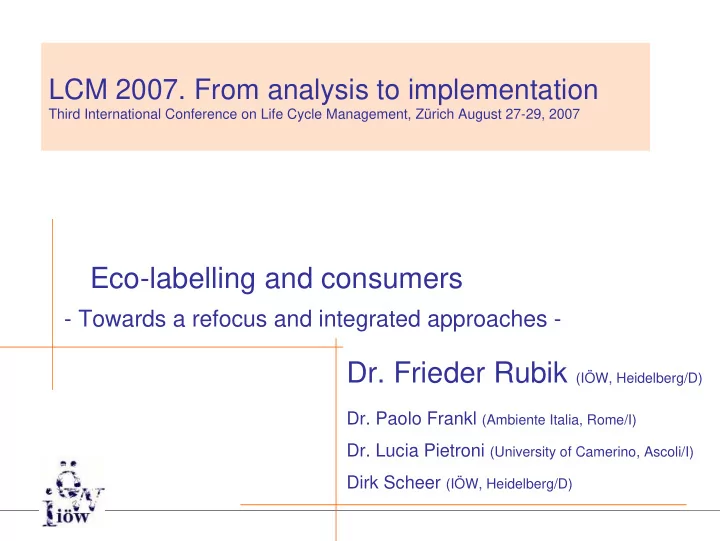

LCM 2007. From analysis to implementation Third International Conference on Life Cycle Management, Zürich August 27-29, 2007 Eco-labelling and consumers - Towards a refocus and integrated approaches - Dr. Frieder Rubik (IÖW, Heidelberg/D) Dr. Paolo Frankl (Ambiente Italia, Rome/I) Dr. Lucia Pietroni (University of Camerino, Ascoli/I) Dirk Scheer (IÖW, Heidelberg/D) Dr. Frieder Rubik: Eco-labelling and consumers – 3 rd LCM conference Zürich August 27-29, 2007 1
Topics • Which experiences exist with regard to effects of eco-labels to contribute to changing production and consumption patterns? • Which factors influence the success and/or failure of an eco-label? • Which future strategy could refocus the concept of eco-labelling and embed it into a path towards sustainable development? Dr. Frieder Rubik: Eco-labelling and consumers – 3 rd LCM conference Zürich August 27-29, 2007 2
EPIS – an overview • Environmental product information schemes (EPIS) • Wide-spread market based environmental policy instrument • Range from mandatory to voluntary approaches • ISO - three voluntary labelling approaches 8 Type I referring to criteria-based certification programmes 8 Type II describing self-declared environmental claims and 8 Type III applicable to quantified product information that is based upon independent verification using present indices. Dr. Frieder Rubik: Eco-labelling and consumers – 3 rd LCM conference Zürich August 27-29, 2007 3
Objectives of EPIS and eco-labels Direct effects Framework Eco-efficient context product innovation (i.e. production patterns) Technology Net Eco-labels context environ- Product & mental substitution EPIS benefits (i.e. change of markets) Market context Eco-efficient product use (i.e. consumption Business patterns) context Indirect effects impact output outcome Dr. Frieder Rubik: Eco-labelling and consumers – 3 rd LCM conference Zürich August 27-29, 2007 4
Resumee – direct effects • Change of supply side (market shifts) 8 Insufficient reliable statistical data 8 Anecdotal evidence 8 Exception: White Swan 8 Dynamic view, i.e. stimulation of product innovations • Change of demand side 8 Knowledge & awareness 8 Trust & confidence • Environmental performance 8 In general: lack of data and theoretical basis 8 EL-products vs. „average“: Smaller „footprints“ 8 IEFE (2006): 2/3 EU-EL applicants wanted improve env. performance Dr. Frieder Rubik: Eco-labelling and consumers – 3 rd LCM conference Zürich August 27-29, 2007 5
Resumee – indirect effects • Policy related effects 8 Linkages eco-labelling and other instruments • Market related effects 8 EL as benchmarks: – Changing whole product portfolio of applicants – Changing product portfolio of branch, competitors, non-applicants – Some empirical evidence 8 EL and the chain – Changes stimulated by procurement (commercial & public) and retailers – Changing demands in suppliers – Some statistical evidence, e.g. � ¾ EU-EL participants with requests on suppliers 8 General increase of consumers‘ environmental awareness � Indirect effects might have similar importance as direct effects Dr. Frieder Rubik: Eco-labelling and consumers – 3 rd LCM conference Zürich August 27-29, 2007 6
Grouping of key influencing factors for success of a labelling approach General & PG specific factors General Product Group specific � Costs for participation & Environment Market Stakeholders Label type fees � Credibility of a � Consider � Look for the � Number of � Identify & in- labelling scheme main environ- quality & price criteria, their vole key stake- mental impacts update � Disseminate holders � Analyse market along life cycle � Choose information � Stimulate structure appropriate awareness of format consumers � Integrate tar- gets, tools & Source: Rubik/Frankl 2005, 264 stakeholders Dr. Frieder Rubik: Eco-labelling and consumers – 3 rd LCM conference Zürich August 27-29, 2007 7
Consequences • Current practise: „Isolated“ approach 8 Application and optimisation of a single tool, i.e. eco-label • Key influencing factors show the need for an „integrated approach“. Some core elements: 8 Linkage with environmental policy targets 8 Links with other IPP & SCP tools 8 Multi-stakeholder approach & shared responsibilities 8 Information and empowerment 8 Differentiation according to product categories Dr. Frieder Rubik: Eco-labelling and consumers – 3 rd LCM conference Zürich August 27-29, 2007 8
Between integrated and isolated approaches STEP 1 - ENVIRONMENTAL OBJECTIVES Identify measures and tools for monitoring the iterative process step by step Identify which are the main environmental problems and related targets STEP 2 - WHO CAUSES OR SUFFERS THE IMPACTS Identify who, where, when in life cycle, causes / suffers the environmental impacts „Integrated approach“ STEP 7 - MONITORING STEP 3 - STAKEHOLDERS Identify the drivers, who have to be the “first-movers” pushing the process STEP 4 - WHICH TOOLS? Identify set of measures which might influence/empower stakeholders: EMS, Voluntary Agreements, Legislation … STEP 5 - ROLE OF EPIS Identify whether labelling approaches are appropriate or other tools are better STEP 6 - WHICH KIND OF EPIS? Identify type and format of EPIS, in function of all target stakeholders, not just of consumers Current practice � Ecolabels type I � EPIS Life cycle „Isolated In every step, different decisions are taken and the number of possible tools is reduced. approach“ Only in some cases Ecolabels type I are the best selection to fulfil the environmental objectives. Dr. Frieder Rubik: Eco-labelling and consumers – 3 rd LCM conference Zürich August 27-29, 2007 9
Conclusions • Limited amount on success stories • Consider direct & indirect effects • Indirect effects might have similar (or more) importance • 11 key influencing factors • Path dependency model: „Integrated“ versus „isolated“ approaches • For more information: EVER-project (DG ENV): http://www.ioew.de/home/downloaddateien/e ver_executive%20summary.pdf Dr. Frieder Rubik: Eco-labelling and consumers – 3 rd LCM conference Zürich August 27-29, 2007 10
Loppu S l o t End Ende Fin τ έ λ ο Fim ς Fine frieder.rubik@ioew.de Dr. Frieder Rubik: Eco-labelling and consumers – 3 rd LCM conference Zürich August 27-29, 2007 11
Recommend
More recommend